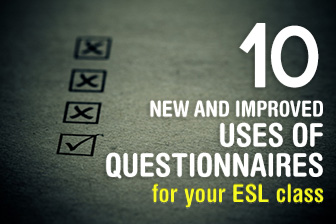Use Your Creativity: 10 Ways to Bring Creative Writing into the ESL Classroom


Why, a questionnaire, of course! That’s why we complete questionnaires when we go to a new doctor, apply for a job or participate in a market survey. Sometimes we even do them for fun or to find out something about ourselves – they’re quite popular in women’s magazines.
Because it is one of the best ways to obtain and share information, we also use them in our ESL class. However, there is a downside to using questionnaires: students are often limited to reading questions from a list or providing an answer from a multiple choice, which is not a very productive use of class time. So, here are 10 new and improved ways to use questionnaires and quizzes in your ESL class, strategies that will get your students to read less and practice more.

Questionnaires or quizzes are great for helping students break the ice the first day of class or obtain information about classmates regarding specific topics, like favorite food, eating habits, sports and hobbies. They help students practice “interview” situations, where one student asks the questions and the other answers them.

Instead of printing out questionnaires with complete questions, which students would simply read out, include just the prompts. Students will have to use them to come up with complete questions themselves. Prompts should look like this:
Make sure they provide just the right level of challenge, but are not too hard to figure out.
To take it up a notch, give them categories instead of prompts. List things like “Hobbies”, “Sports”, “Food”, “Movies” and have students come up with different types of questions on their own.
This puts a fun spin on the whole questionnaire activity. Have students write the questions they will ask their partner based on the prompts/categories above AND predict what they will say. Then they proceed with the interview and compare their predictions to the answers they get. They may be in for a surprise!
A great way to maximize speaking time is to have each student complete a questionnaire for his/her partner and then summarize for the class what they have found out about this person: “Carla likes to play sports in her free time and is a huge baseball fan. She…” The great thing about this type of activity is that you can use any tense or instruct them to use verbs for reporting.
A great way to get your students to put their deductive skills to the test! Give each pair of students a questionnaire with no title. Students work together to figure out what kind of questionnaire it is and what type of context you might find it in. For example, if the questionnaire asks a series of questions about eating habits (what students eat and drink and how often they do it) students will probably guess that this type of questionnaire might be used by a doctor, dietician or nutritionist.
Students complete the questionnaire for themselves but leave out their names. You can then pass them around or put them up on a wall, and see if they can guess whose questionnaire each one is.
Instruct your students to complete their questionnaires, but they must lie three times. Partners try to sniff out the lies. Another option is to have students lie as their partner asks the questions – he or she has to guess which statement is not true.
Have students compete to come up with the craziest questionnaire ever. In it, they should include questions that are virtually impossible to answer (How many times do you blink a day? How many times have you been sick since the day you were born? What was the first song you ever heard on the radio?) The goal here is not to answer these crazy questions – most of them are impossible to answer – but to encourage creativity while they use correct grammar and structure at the same time.
Ask each student to answer the questions as a famous person or celebrity would. This is a great time to make use of some of your celebrity photos. Partners read the answers and try to guess which celebrity their classmate was pretending to be.
It is quite common for magazine questionnaires to come with an answer key that assigns points for each type of answer. Then, based on the number of points, you fall into a particular category. Here’s an example of an online quiz that tells you how environmentally friendly you are. And here’s a printable version from the British Council, a quiz called How Green Are You? This type of quiz is a great lead in to a discussion about what we can do to conserve the planet’s resources.
But be sure to include quizzes and questionnaires in your class every now and then. They’re fun and may even shed some light on issues your students could be concerned about, like their health and the environment.
What’s your experience using questionnaires in the ESL classroom? Tell us all about it below!